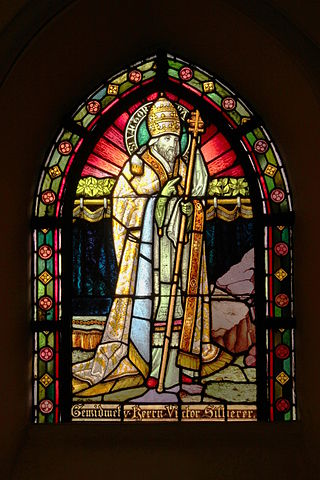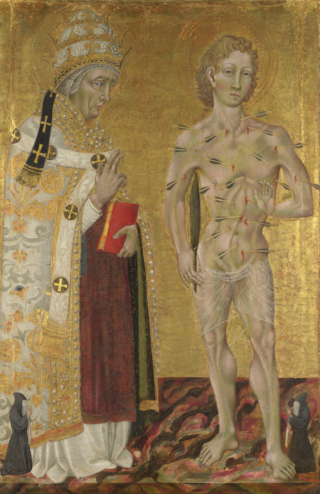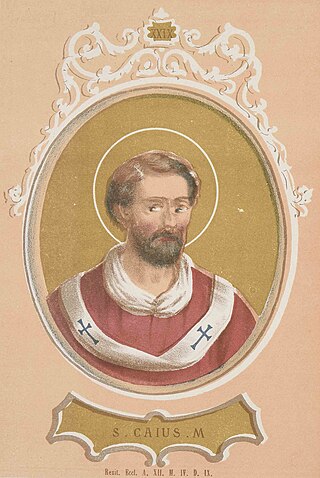
Pope Boniface I was the bishop of Rome from 28 December 418 to his death on 4 September 422. His election was disputed by the supporters of Eulalius until the dispute was settled by Emperor Honorius. Boniface was active in maintaining church discipline, and he restored certain privileges to the metropolitical sees of Narbonne and Vienne, exempting them from any subjection to the primacy of Arles. He was a contemporary of Augustine of Hippo, who dedicated to him some of his works.

Pope Callixtus I, also called Callistus I, was the bishop of Rome from c. 218 to his death c. 222 or 223. He lived during the reigns of the Roman emperors Elagabalus and Alexander Severus. Eusebius and the Liberian catalogue list his episcopate as having lasted five years (217–222). In 217, when Callixtus followed Zephyrinus as Bishop of Rome, he started to admit into the Church converts from sects or schisms. He was killed for being Christian and is venerated as a saint and martyr by the Catholic Church.

Pope Siricius was the bishop of Rome from December 384 to his death. In response to inquiries from Bishop Himerius of Tarragona, Siricius issued the Directa decretal, containing decrees of baptism, church discipline and other matters. His are the oldest completely preserved papal decretals. He is sometimes said to have been the first bishop of Rome to call himself pope.

Pope Sixtus I, also spelled Xystus, a Roman of Greek descent, was the bishop of Rome from c. 117 or 119 to his death c. 126 or 128. He succeeded Alexander I and was in turn succeeded by Telesphorus. His feast is celebrated on 6 April.
Pope Sixtus III was the bishop of Rome from 31 July 432 to his death on 18 August 440. His ascension to the papacy is associated with a period of increased construction in the city of Rome. His feast day is celebrated by the Roman Catholic Church and Eastern Orthodox Church on 28 March.
Pope Valentine was the bishop of Rome and ruler of the Papal States for two months in 827. He was unusually close to his predecessor, Eugene II, rumoured to be Valentine's father or his lover, and became pope before being ordained as a priest. He was a nobleman and elected by nobility, which later became the custom.

Pope Victor I was a Roman African prelate of the Catholic Church who served as the Bishop of Rome in the late second century. The dates of his tenure are uncertain, but one source states he became pope in 189 and gives the year of his death as 199. He was born in the Roman Province of Africa—probably in Leptis Magna. He was later considered a saint. His feast day is celebrated on 28 July as "St Victor I, Pope and Martyr". He was of Berber origin.
Pope Zosimus was the bishop of Rome from 18 March 417 to his death on 26 December 418. He was born in Mesoraca, Calabria. Zosimus took a decided part in the protracted dispute in Gaul as to the jurisdiction of the See of Arles over that of Vienne, giving energetic decisions in favour of the former, but without settling the controversy. His fractious temper coloured all the controversies in which he took part, in Gaul, Africa and Italy, including Rome, where at his death the clergy were very much divided.

Pope Anicetus was the bishop of Rome from c. 157 to his death in April 168. According to the Annuario Pontificio, the start of his papacy may have been 153. Anicetus actively opposed Gnosticism and Marcionism. He welcomed Polycarp of Smyrna to Rome to discuss the Easter controversy.

Pope St. Dionysius was the bishop of Rome from 22 July 259 AD to his death on 26 December 268. His task was to reorganise the Catholic Church, after the persecutions of Emperor Valerian I, and the edict of toleration by his successor Gallienus. He also helped rebuild the churches of Cappadocia, devastated by the marauding Goths.

Pope Fabian was the bishop of Rome from 10 January 236 until his death on 20 January 250, succeeding Anterus. A dove is said to have descended on his head to mark him as the Holy Spirit's unexpected choice to become the next pope. He was succeeded by Cornelius.

Pope Caius, also called Gaius, was the bishop of Rome from 17 December 283 to his death in 296. Little information on Caius is available except that given by the Liber Pontificalis, which relies on a legendary account of the martyrdom of Susanna of Rome for its information. According to legend, Caius baptized the men and women who had been converted by Tiburtius and Castulus. His legend states that Caius took refuge in the catacombs of Rome and died a martyr.

Pope Gelasius I was the bishop of Rome from 1 March 492 to his death on 19 November 496. Gelasius was a prolific author whose style placed him on the cusp between Late Antiquity and the Early Middle Ages. Some scholars have argued that his predecessor Felix III may have employed him to draft papal documents, although this is not certain.
Pope John I was the bishop of Rome from 13 August 523 to his death. He was a native of Siena, in Italy. He was sent on a diplomatic mission to Constantinople by the Ostrogoth King Theoderic to negotiate better treatment for Arians. Although John was relatively successful, upon his return to Ravenna, Theoderic had him imprisoned for allegedly conspiring with Constantinople. The frail pope died of neglect and ill-treatment.

Pope Felix IV was the bishop of Rome from 12 July 526 to his death. He was the chosen candidate of Ostrogoth King Theodoric the Great, who had imprisoned Felix's predecessor, John I.
Pope Vigilius was the bishop of Rome from 29 March 537 to his death. He is considered the first pope of the Byzantine papacy. Born into Roman aristocracy, Vigilius served as a deacon and papal apocrisiarius in Constantinople. He allied with Empress Theodora, who sought his help to establish Monophysitism, and was made pope after the deposition of Silverius. After he refused to sign Emperor Justinian I's edict condemning the Three Chapters, Vigilius was arrested in 545 and taken to Constantinople. He died in Sicily while returning to Rome.

Saint Lawrence or Laurence was one of the seven deacons of the city of Rome under Pope Sixtus II who were martyred in the persecution of the Christians that the Roman emperor Valerian ordered in 258.
Pope Donus was the bishop of Rome from 676 to his death. Few details survive about him or his achievements beyond what is recorded in the Liber Pontificalis.

August 9 - Eastern Orthodox liturgical calendar - August 11

Felicissimus and Agapitus were two of the six deacons of Pope Sixtus II who were martyred with him on or about 6 August 258, Felicissimus and Agapitus on the same day as the Pope. The seventh deacon, Lawrence of Rome, was martyred on 10 August of the same year.















